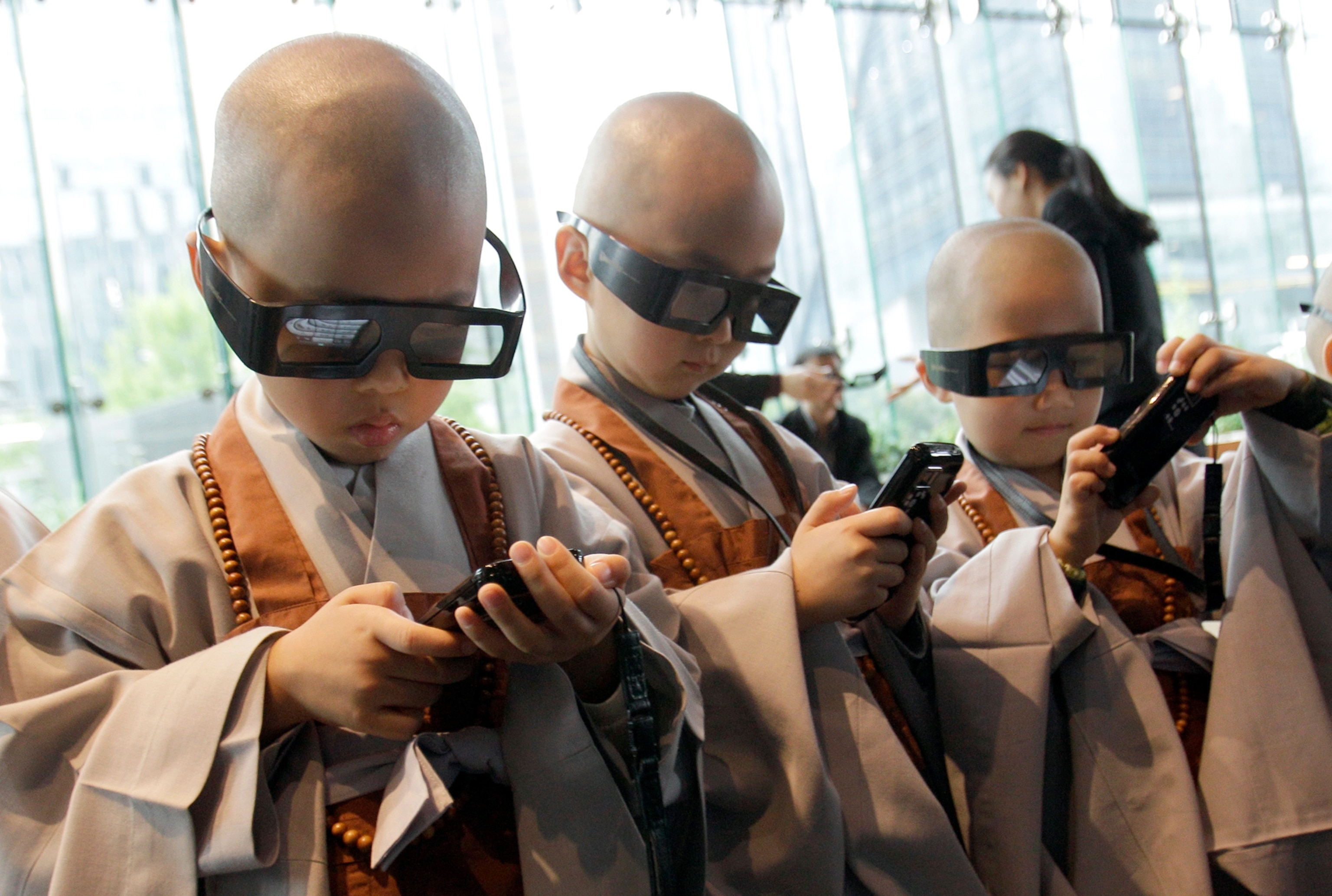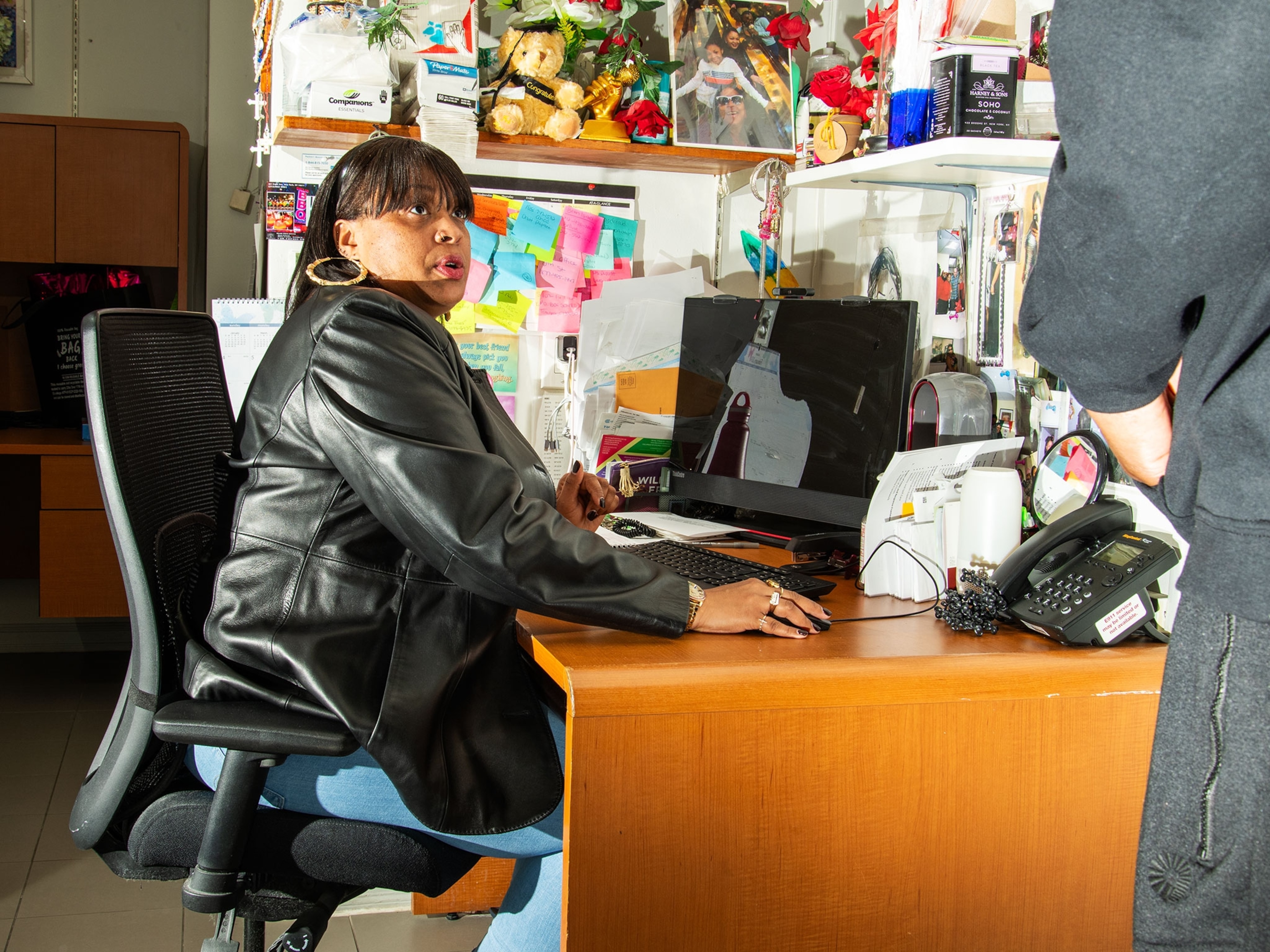How technology is reshaping religion
Smartphone apps, social media, and artificial intelligence are all making religion more accessible. Is it enough to slow recent declines in religious beliefs?

Looking at demographic data, a simple story about religion in the United States appears: it’s on the decline.
According to Gallup, 98 percent of Americans believed in God in 1952, and only 81 percent did in 2022. Twenty two percent of Americans in a 2023 study by the Pew Research Center identified as spiritual but not religious; 28 percent in 2024 described themselves as atheists, agnostics, or nothing in particular, often called the “nones.” Across North America and Europe, similar numbers track the decline in people affiliated with an organized religion. (The numbers are quite different in the Middle East, South Asia, and Latin America, where religion is growing.)
But the demographic data hides a more nuanced story about the future of religion.
Villanova theology professor Sister Ilia Delio has closely observed the shifts of faith, belief, and perception. And while she has watched the trends she doesn’t believe that faith in God is vanishing. “It hasn’t gone away, but it’s showing up in a new way,” she says. “That really changes how we think about these questions of God or faith.”
Technology—smartphones, social media, and even artificial intelligence—is fueling a lot of this change, altering the way people find religious teachings, how they find like-minded individuals, and how they pray. Robot priests are guiding people in search of answers to the Big Questions and one church in Switzerland recently unveiled an AI Jesus in one of its confessionals. Might these new technologically assisted ways to reach the masses lead to a religious revival? The future of religion could be a lot stranger than what the demographic data implies.
(How will religious populations change in the coming decades?)
On Tiktok, religion finds you
God and religion appear to be everywhere in cyberspace. On a computer or phone, you can find a denomination or religion that aligns with your values, or simply a set of ideas that feels like a better match. Fifty years ago, if you had a question about your faith, you might ask your religious leader or a prominent person in your community. “It used to be that a person always went to the local rabbi to ask a question. Today, you don’t go to the local rabbi, you ask a question on Google,” says Pinchas Goldschmidt, president of the Conference of European Rabbis.
Of course, the intermingling of technology and religion is nothing new. The introduction of the printing press in 15th-century Europe made possible the mass production of books. Newly formed Protestant groups used it to spread their revolutionary ideas about Christianity, while the Catholic Church sought to prohibit works considered heresy. In today’s internet-driven information age Sister Ilia notes, “We have everything here at our disposal. So it’s like cherry picking. If I don’t like it, I’m not going to take it. If I like it, I take it.”
This democratization of knowledge is on full display on the internet with social media platforms like Instagram, TikTok, and Douyin jammed with short-form videos and such hashtags as #diwali and #easter. Although some content is created by individuals with religious training, much is produced by others with a fervent calling to post or find like-minded people. Thousands of smartphone apps offer to help you worship the right way and more. There are apps that let Muslims locate prayer spaces as well as halal restaurants. There is an app that shows Buddhist monks demonstrating gravity-defying twirls, leaps, and backflips. “You now have access to religious ideas and practices from around the world that you didn’t really have access to before,” says Robert Geraci, Knight Distinguished Chair for the Study of Religion and Culture at Knox College. “That gives you a new perspective on whatever it is that you in particular perceive.”
ShanDien Sonwai LaRance (Hopi, Tewa, Navajo,and Assiniboine) grew up in the western United States in the Hoop Dance tradition. Hopi hoop dancing is a form of prayer and a way to connect with the spirits, and LaRance has made it her mission to share and explain the tradition on Instagram, TikTok, YouTube, and Facebook.
Melinda Strauss started as a kosher food blogger and discovered that people were intrigued that she was a modern Orthodox Jew. “I realized that people really don’t know anything about Jews, or about our customs and our laws. So I started answering questions with videos, and it really took off.” She now has 1.3 million TikTok followers and 156,000 followers on Instagram.
Nuns jumping from a cupboard or indicating whether they prefer evening or morning prayer while “It’s Tricky” by the hip-hop group Run DMC is playing is not what you might expect to find among a deeply religious congregation. But the Daughters of St. Paul are a new generation of religious sisters. Their order was established to follow the lead of the Apostle, and they use media to spread the word about Christ. With 157,000 followers on TikTok, they have deservedly earned the nickname Media Nuns. Their mission is helped by their genuine warmth. Says Sister Orianne Pietra René, “Not only are we authentically sharing ourselves, because we like to have fun, but are bringing the whole of who Christ is to the whole of the person who is longing for that joy and that vitality, that fullness of life.”
Back in 2019 Sabah Ahmedi, the imam at Baitul Futuh mosque in London, was in a tea shop with a friend. The two were discussing misconceptions about Islam. That talk inspired Ahmedi to build his Young Imam social media brand to “help people understand Islam better.” He posts almost every day. On his sites, he talks both seriously and with humor about everything from such rituals as ablution—“We have to wash before we offer our prayer, because it’s getting in the mindset of cleanliness”—to his favorite coffees.
Artificial Intelligence is helping religious leaders innovate
But even more than people like LaRance, Strauss, and Imam Ahmedi taking to social media to spread the word, religion is being affected by the phenomenal growth of artificial intelligence.
Among these complex technologies are large language models, systems trained on vast amounts of data that can analyze and process language and generate believable humanlike responses.
Some religious leaders have embraced this development. Priest Caru Das Adhikary at Utah’s Sri Sri Radha Krishna Temple loves performing, noting, “My interest is in telling stories and doing rap music and putting together songs. I use AI for practically every single composition I make.” He relies on Google Gemini to turn a verse of Sanskrit Hare Krishna text into rap. Caru Das admits that at times what it produces is trite, so he spends time correcting and polishing the words. “It jump-starts me. I work on it, claim it. I make it mine.”
Ed Stetzer, the dean at Biola University’s Talbot School of Theology, recently prepared a sermon on a Reformation doctrine called Solus Christus, or in Christ alone. He asked ChatGPT for quotes from second- and third-century church fathers relating to the doctrine. AI offered some examples, but as Stetzer says, AI is not always right: “It gets me started on the trail. There’s some strength to that.”
Others are more circumspect. Since AI technologies are being developed separate from established religious institutions and communities, people accessing them are not interacting with someone who knows them, their family, or why they are seeking something. For instance, those searching for answers from a Jewish perspective might not be interested in one that offers a Southern Baptist interpretation. “We’re losing the personal touch, and we’re losing also the emotion,” says Rabbi Goldschmidt, who has a master’s in computer science from Johns Hopkins University. “What is the social context? What is the spiritual as well as the material status of the human asking this question? There’s no absolute question. There’s no absolute answer.”
(Can religion make you happy? Scientists may soon find out.)
Robot priests guide the faithful
Some religions are even starting to incorporate technology into their worship in the form of robot priests. Gabriele Trovato grew up in the Italian port city of Livorno. As a youth he took for granted the religious iconography that suffuses that largely Catholic nation. “In my hometown we have a lot of sacred art. Statues are part of the landscape. Even in the middle of the streets you see niches with the Virgin Mary,” he says. Based on those statues Trovato, an associate professor at Tokyo’s Shibaura Institute of Technology, crafted SanTO (Sanctified Theomorphic Operator).
The small robot has the appearance of a neoclassical saint. It is designed to be accessible for older people as well as those who are isolated or may have mobility issues. Individuals can use an electric candle to touch SanTO’s hands and ask it a question, accessing an extensive database that contains knowledge of the Bible, prayers, and the lives of the saints.
In Beijing’s Longquan Temple there is a robot named Xian’er. With his yellow robe and somewhat perplexed look, as he chants Buddhist mantras and explains the basic principles of faith. An actual size robotic elephant recently replaced a live and chained one, and it takes part in cruelty-free rituals at the Irinjadappilly Sree Krishna Temple in Thrissur, India.

Meanwhile, in the quiet serenity of Kyoto’s 17th-century Kodaiji Temple stands Mindar, a more than six-foot-tall robot with porcelain-colored skin, a head, hands, arms that can move, and an exposed aluminum skeleton. A mechatronic android with a contemplative gaze that represents Kannon, the bodhisattva of compassion, and can discuss. Zen Buddhism was the aim of Tensho Goto, Kodaiji’s former chief steward. He wanted something with a face that projected an affectionate sense of relatability, so people would feel comfortable with it.
“This was the original hope for Mindar, something that could use machine learning that’s drawing on ancient Buddhist texts,” says Daniel White, a research associate at Cambridge University who studies machines programmed with emotional intelligence. “Could they create an artificial intelligence and artificial life-form that could answer our questions about the nature of reality, about the Buddha in a way that would perhaps be more accu- rate to what the Buddha would actually teach?” To White’s surprise, many believers who approached Mindar seemed open to what it said.
A temple in Japan has also offered funeral services for robots. Back in the late 1990s Sony introduced a mechanical dog called aibo. The Japanese public embraced their robot rovers. Sadly, the machines eventually broke down. The faithful in this largely Buddhist nation believe that all creatures as well as inanimate objects have souls and deserve proper funerals. As White notes, instead of tossing them out, they brought them to Kofukuji Temple in Isumi, where prayers were offered to disambiguate the aibos’ souls and send them to the Pure Land. Head priest Ōi Bungen saw the ceremony as a way to also teach participants the deeper aspects of Buddhist philosophy.
Will social media, smartphone apps, and AI-powered robots transform how people experience faith?
Despite Xian’er’s mantras and Mindar’s calm gaze, robots are impersonal machines programmed to mimic. How much faith can the faithful put in AI algorithms? How much can one trust a smartphone app or a robot reciting prayers and delivering sermons?

As a sign that religious leaders from around the world are taking seriously such questions, for several years they have been discussing the issues, and in July 2024 representatives from many of the world’s major faiths gathered in Hiroshima to promote the ethical development of AI. In a city destroyed by the unleashing of a devastating new technology—the atomic bomb—16 new signatories added their names to the Rome Call for AI Ethics. Working with tech companies and university think tanks, the agreement calls for the responsible use of AI.
As the religious leaders who convened in Hiroshima know, technology can and should be harnessed to help humanity. The traditions of their religions and all others around the world, though, are personal and sacred. The challenge for the faithful is to be like Miranda, the daughter of the sorcerer Prospero in Shakespeare’s The Tempest, who is beguiled by signs of a world she never knew as she exclaims, “How beauteous mankind is! O brave new world, That has such people in’t.” We can approach these ideas with a curious mind while also viewing them with care. Yet Aldous Huxley’s Brave New World, a 20th-century novel novel named for Miranda’s speech, is a cautionary tale, in which the characters’ lives are dictated by dystopian efficiency in a technologically advanced world devoid of magic and religion. “It’s how we use technology—not to displace religion, but to enhance it,” says Sister Ilia of faith in the digital age. “How can we become more conscious of belonging to one another? How can we become more conscious of a power of life that we name as God?”







